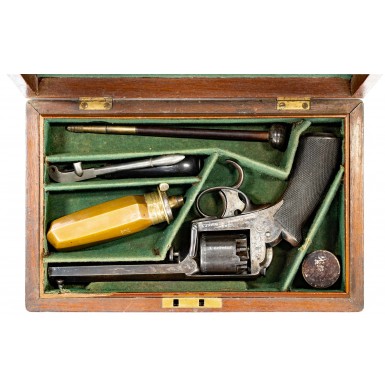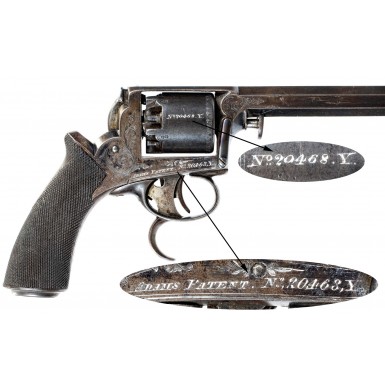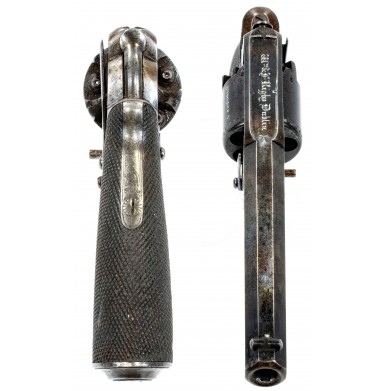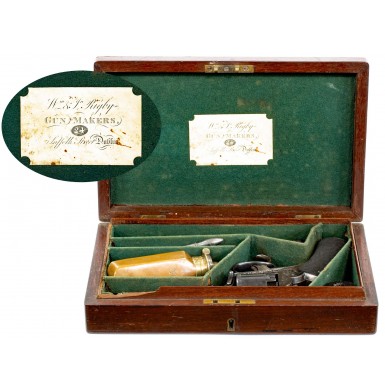Crimean War 39th Regiment of Foot Marked Cased 1st Model Tranter Revolver
- Product Code: FHG-2225-SOLD
- Availability: Out Of Stock
-
$1.00
The revolvers produced by English gunmaker William Tranter were some of the most advanced and modern handgun designs to see use by the Confederacy during the course of the American Civil War. Tranter was born in 1816 and died in 1890, and during his working life he was one of the most prominent Gun, Rifle & Pistol Makers in the Birmingham (England) gun trade. He went into business for himself circa 1840, after completing his apprenticeship with Hollis Brothers & Co, which he had begun in 1830. Tranter continued in the trade until 1885, just five years before his death.
In 1840, after spending a decade learning the gun trade at Hollis Bros & Co (later Hollis & Sheath), Tranter bought the established gun making business of Robert Dugard at 29 ½ Whitehall Street. Over the next decade he worked for himself and was also involved in joint ventures with his old employers John & Isaac Hollis as well as with Isaac Sheath. By 1850, he had located his primary business at 50 Loveday Street, where he was listed in a period directory as having “shops, sheds, steam machinery, yard & premises”. Tranter secured his first British patent related to firearms in October of 1849 when he registered a “pepperbox mechanism and lever catch for pistol locks”. In January 1853, he registered British Patent Number 212 (1853) for a pair of “self-cocking” pistol mechanisms and a safety mechanism. In December of the same year, he registered designs for a double-action revolver mechanism, lubricated bullets and wadding, and a breech loading mechanism, all of which were covered by Patent Number 2921 (1853). In August of 1856, he registered the designs for a “double trigger revolver mechanism”, along with several other designs, all of which were covered by British Patent Number 1913 (1856). Tranter continued patenting firearm designs as late as 1887, even though he was no longer directly active in the gun trade.
Tranter’s most successful series of arms were his “self-cocking” revolvers, which were initially introduced in 1853. The earliest revolvers utilized Robert Adams’ patent for a solid, one-piece frame and barrel that were machined from a single forging. Tranter’s initial production run of revolvers included both Adams 1851 Patent lock works, and Tranter's own patented lock works. The original “Tranter” type revolvers, known to collectors as 1st Model Tranter or sometimes “Adams-Tranter” revolvers due to the frame marking, had no provision for a fixed loading lever. The lever swiveled on a stud that projected from the left side of the frame, which had no provision to retain the lever when it was mounted on the revolver. The lever was intended to be stored in a case or carried in the pocket; hardly a practical solution if the user actually had to reload the revolver in the field. Most of these guns were manufactured on Adams Patent frames and have Adams Patent serial numbers, really patent tracking numbers to pay royalties to Adams, and these serial numbers are followed by a Y suffix.
The 2nd Model Tranter revolvers also had a pin on the frame that allowed the attachment of a removable loading lever, but the pin had a small projection that allowed the lever to remain attached to the gun unless a keyway notch in the lever was aligned with the stud projection to remove it. The later example of these guns, manufactured after about 1856, have Tranter Patent serial numbers and end with a T suffix. These guns not only include Tranter Patent lock works, but also a newly improved version of the Adams solid frame, which was patented by Tranter in 1856. At this point Tranter revolvers rarely have Adams serial numbers.
The 3rd Model Tranter revolvers had a more permanently attached loading lever, which was secured by a screw. The 3rdModels appear to have all been produced in the T suffix Tranter serial number range. All three of these models were based on his “double-trigger” system (initially referred to as his “hesitating mechanism” on the early production guns), which utilized a second “trigger” under the trigger guard to rotate the cylinder and cock the hammer. The trigger inside the triggerguard was used to trip the sear and release the hammer to fire the revolver. The 4th Model Tranter revolvers, which were introduced in 1856 and are all in the Tranter T-suffix series, used a single trigger. These guns utilized a lock work that would be referred to as a conventional “double action” mechanism today.
All of the Tranter revolver patterns were produced in a variety of calibers, with 54-Bore (.442) “Holster Size” and 120-Bore (.338) “Pocket Size” revolvers being the most commonly encountered calibers and frame sizes, and the mid-sized 80-Bore (.387) “Belt Size” being less often encountered. Some of the guns were also produced in the exceptionally large and powerful 36 and 38 bore sizes, which were larger versions of the holster size guns, and were about .50 caliber! Barrel lengths varied as well, with the larger caliber arms typically having longer barrels, and the smaller caliber guns having shorter barrel. All of the guns were 5-shot percussion revolvers, and typically featured checkered one-piece walnut grips, although smooth wooden grips and other grip materials are known to have been used on a special order basis.
The Tranter patent revolver was the primary competitor with the Adams and Beaumont-Adams patent revolvers in England and was also exported widely. Pre-Civil War Tranter revolvers are known with US retailer marks, indicating that his designs were at least somewhat successful in the United States. The majority of the retailer marked guns are from the southern states, with the largest majority of them being marked by New Orleans retailers. Based upon extant examples, the firm of Hyde & Goodrich (later Thomas, Griswold & Co) appears to have been the primary importer of Tranter Patent revolvers into the southern United States. Most of these retailer-marked guns were sold cased with accessories, although some guns were certainly sold without the expensive casings and accouterments. During the course of the American Civil War, it appears that the importation of Tranter revolvers was somewhat limited, at least in terms of Confederate central government purchases. However, period advertisements in the south and extant examples with southern provenance make it clear that the guns were imported by blockade-runners as speculative items for sale in the south. Such famous Confederates as General John Hunt Morgan (3rd Model #3758T), General J.E.B. Stuart (4th Model #8673T), General John Magruder and Colonel Dabney H. Maury (3rd Model #7993T), who served on the staff of General Earl Van Dorn, all owned documented 54-Bore Tranter revolvers. The famous “Pratt Roll”, which lists the revolvers in the possession of Lt. Julian Pratt’s squad of troopers in Company H of the 18th Virginia Cavalry in July of 1864, lists two Tranter revolvers, with the serial numbers 15,465 and 15,476. This indicates that Tranter revolvers in the mid 15,XXX serial number range were in use by southern forces, and in the field by that time. While models are not listed in the list, it is generally assumed that these guns were either 3rd of 4th model revolvers and were likely 54-Bore. Other Tranter revolvers with southern provenance include guns which are retailer marked by T.W. Radcliffe of Columbia, SC. Additionally, a March 10, 1863 advertisement in the Richmond Times Dispatch for H. E. Nichols of Columbia, SC read in part:
“Fine English Revolvers. Just received from England, six Tranter’s fine revolving pistols, 80 and 120 bore. Price $220 each”.
All of this evidence indicates that at least some of the Tranter revolvers produced during (as well as prior to) the Civil War, saw Confederate use. Dating Tranter revolvers based upon their serial numbers is somewhat problematic, as frames were sometime produced in advance and the guns completed at a later date. What we do know is that the “T” serial number suffix came into use around serial number 2200, sometime between 1854 and 1856. We also know that Tranter produced revolvers using Adams patent serial numbers and a “Y” suffix from about 1853 through about 1856. These guns appear in several serial number ranges, as assigned by Adams, including the 2X,XXX range. All “Y” suffix guns predate the Civil War by at least four or five years. From extant examples of Tranters with specific presentations, dated invoices and dates of usage associated with them, it appears that those Tranter revolvers with serial numbers through about the 20,XXX range (and possibly some of the early guns in the 21,XXX range) with T suffixes appear to have been produced prior to the end of 1865, making them “Civil War era”. Post-Civil War southern retailer marks begin to appear in the 21,XXX range, suggesting that these guns are likely 1865 production, or possibly slightly later.
Offered here is a very scarce, early production cased 1st Model “Adams-Tranter” Revolver in VERY GOOD+ condition. The revolver is in the very desirable, and less commonly encountered 80-Bore, which is approximately .386 caliber. The brass escutcheon of the case is additionally engraved with the Old English style initials R R over 39th Regt. While there is no name officially associated with the cased revolver, it can safely be assumed that the gun was used by an English officer in the 39th Regiment of Foot. Officers were required to provide their own uniforms, equipment and sidearms, and this revolver would have been a perfect officer’s revolver for use during the Crimean War. The 1st Model “Adams Tranter” revolvers were introduced in 1853 and remained in production through about 1856. The Crimean War erupted in October of 1853 and ran through the end of March 1856. The storied 39th Regiment of foot was dispatched to the Crimean during the spring of 1854, after spending much of the previous decade on station in India. The 39thparticipated in the Siege of Sevastopol that started during the winter of 1854 and lasted for nearly a year. The regiment remained in service on the Crimean Peninsula through 1856 when they were sent to a duty station in Canada. Locating a list of junior officers of the 39th Regiment of Foot circa 1853-1856 would likely allow the full identification of this revolver, as it is unlikely that many would have had the initials “R R”.
The mid-sized revolver measures about 9 ¾” in overall length, making is large enough for belt carry and yet small enough for pocket carry. The pistol is marked ADAMS’ PATENT No 20,468,Y on the lower right side of the frame. This is an Adams assigned serial number range, which started at 20,000, underscoring how early this revolver is in the production timeline. The cylinder is engraved with the matching serial number and reads No 20,468 Y. The left side of the frame of the gun is not marked with the typical arced two-line Tranter cartouche is commonly encountered on later production revolvers. However, this mark is present on the left side of the trigger web and reads W. TRANTER’S / 1066 / PATENT in three lines, with the upper and lower lines forming an oval cartouche. The revolver is retailer marked on the top strap and is engraved in a single line: Wm & Jn Rigby Dublin. The retailer mark is engraved in an Old English style, similar to that way the case lid escutcheon is engraved. The firm of John Rigby & Company was established in Dublin, Ireland in 1775. In 1816, the “second” John Rigby joined the firm and in 1818 the company was known as William & John Rigby, with that branch of the business remaining in Dublin until 1892. At that time Truelock & Harris acquired the Irish portion of the business, which subsequently closed its doors in 1897. In 1851, John Rigby III displayed much of his work at the Great Exhibition in London and in 1858 began collaborations with Joseph Needham in the design of self-contained cartridge firearms. It would be John Rigby III who would be responsible for the world-renowned fame of the Rigby name when associated with firearms. In 1866 John Rigby III established John Rigby & Company at 72 St. James Street in London, where the firm remained until 1907, at which time they relocated 43 Sackville street. In 1900, the firm was renamed John Rigby & Co LTD. During the early 1870s Rigby concentrated his design efforts on producing high quality match rifles, as well as working on designs to improve and enhance cartridge firearms, especially double rifles for big game hunting. In 1879, Rigby debuted his “Rising Bite” series of big game double guns that remain in production to this day. In fact, if you would like to order a Rigby Rising Bite (only available in .470 or .500 Nitro Express currently), be prepared to wait at least three years. You should also be prepared for the price, as the guns start at £95,000 (about $145,000) and go up from there. In 1887, Rigby was appointed the Superintendent of the Royal Small Arms Factory at Enfield Lock (RSAF), where he would continue to advance gun designs, and would collaborate with Paul Mauser in 1897 to develop the Mauser “Magnum” bolt action, which remains one of the strongest and most reliable actions for high powered cartridges to this day. Over the next decade Rigby would develop some of the most powerful big game cartridges ever produced, including the .450 Nitro Express (1898), the .350 No 2 and .350 Magnum (1908) and the world famous .416 Rigby (1911). John Rigby III died in 1916, but his name and the family business live on, with the company eventually bought by a series of investment groups that finally reunited the Rigby and Mauser names in 2103 after 100 years.
As noted above, the revolver is in about VERY GOOD+ condition. The gun shows moderate wear and use but still remains in fairly crisp condition with sharp edges and lines throughout. The gun retains about 20%+ of its original blued finish on the barrel, which is fading, thinning and shows moderate loss from holster wear. The strongest areas of blue are on the lower three flats of the barre. The balance of the barrel has a dull smoky-gray patina with flecks of blue here and there. The metal is mostly smooth with some scattered surface oxidation and some scattered pinpricking. The 5” octagonal barrel bears the expected London commercial view and proof marks of {CROWN}/GP and a {CROWN}/V on the left angled flat near the front of the frame juncture. These marks are somewhat light. The cylinder is also marked with the usual London commercial proof and view marks, alternating between the chambers. The cylinder retains some traces of blue and shows the same dull smoky blue-gray patina as found on the barrel. The cylinder retains all of its original cone (nipples), and they are all in very good and useable condition with decent edges and no significant battering or damage. The cylinder has light foliate themed boarder lines engraved around its front edge near the chamber mouths. The same pattern is found engraved around the muzzle of the revolver as well. The cylinder also shows scattered light surface oxidation and some lightly scattered pinpricking, with more moderate oxidation and some moderate pitting in the recesses around the cones. The frame, backstrap and buttcap are all neatly engraved with crisp foliate themed patterns and scrolls. The frame retains some strong traces of blue in the protected areas, with the balance of the exposed metal having the same dull bluish-gray smoky patina found on the barrel. Again, the metal is mostly smooth and shows scattered light surface oxidation and some minimal pinpricking. The bore of the revolver rates about VERY GOOD+ as well, with strong five-groove rifling. The bore is mostly bright but does show some moderate frosting and light pitting scattered along its length. The left side of the frame retains the original Tranter’s patent spring safety that prevents the hammer from contacting the cones unless the trigger is pulled. Using the safety also allows the cylinder to be turned freely for loading. The original arbor pin retaining spring catch is also present on the forward right side of the frame. Both the safety and the arbor catch are in perfect mechanical condition and both retain some dull traces of their original fire blued finish. The cylinder arbor pin appears to be a very high quality replacement. It matches the balance of the revolver in terms of patina and is not immediately noticeable as a replacement. The original, removable Tranter “1st Model” loading lever included in the casing. It is not attached to the frame, as the 1st Model pivot stud on the frame does not have any facility to secure the lever. The unmarked lever functions smoothly and correctly when placed on the frame stud. The original front sight is dovetailed in place near the muzzle as well. The checkered walnut grip is in about FINE condition and matches the condition of the pistol very well. The grip is solid and free of any breaks, cracks or repairs. The checkering remains relatively sharp but does show some very light wear and minor flattening of the sharp end of the checkering. The action of pistol work very well and the revolver times, indexes and locks up, exactly as it should. As with all of the double-trigger Tranter percussion revolvers, the lock up is only accomplished when the lower trigger is pulled full to the rear in the “full cock” position. Otherwise the cylinder is free to rotate.
The pistol is contained within its original mahogany veneered English retailer casing with the paper Rigby retail label inside the lid. The paper label reads:
Wm & Jn Rigby
GUN MAKERS
24
Suffolk Street DUBLIN
The compartmentalized case is lined in dark green baize and contains a variety of accessories. The casing retains the original “Bible” hinges and a brass lock escutcheon on the front. The case is in about VERY GOOD condition and shows some moderate wear and finish loss on the exterior. The case an old repaired crack that runs almost the width of the lid near the front edge. There is also some minor separation at some of the joints, a couple of other minor cracks and the usual expected scattered bumps, dings, minor surface mars and light scratches. The brass lock escutcheon is present in the front of the case, but the key is no longer present. The interior compartments are lined with a faded green baize that shows good age and moderate wear and appears to be absolutely original to the case. There is some minor glue repair to the lining here and there. The case is in solid condition with no serious weakness to the exterior structure itself. The interior compartment dividers show moderate wear, as well as some weakness and looseness that should probably be addressed with some minor maintenance to prevent total separation of some of the dividers. There is also about a 2”x2” chipped area missing from the inner lip of the casing, that appears to be a very old break.
The casing contains the following accessories for the revolver:
1) A lozenge shaped copper Powder Flask in about VERY GOOD overall condition. The body of the flask shows scattered bumps, dings and mars. The body is also engraved with a large Old English R that matches the engraving pattern on the topstrap of the revolver and the lid escutcheon’s double R initials. The polished brass top is clearly marked in two lines W. BATRAM / PATENT. The fixed spout is bent and slightly damaged. The charging lever of the flask functions smoothly and correctly.
2) A jappaned Cap Tin in VERY GOOD condition. The tin is unmarked and shows light to moderate wear.
3) The detachable 1st Model Tranter Loading Lever in VERY GOOD condition.
4) An Ebony Handled Cone Wrench in VERY GOOD condition. Like most cone wrenches, this one has a removable vent pick in the handle.
5) Cleaning Rod in VERY GOOD condition. The wooden cleaning rod is in very nice condition and shows some light to moderate handling marks. The rod has a removable brass jag for cleaning the bore, and a brass mounted steel ball extractor (concealed by the jag) for unloading the cylinder. The rod appears to be of polished rosewood.
All of the accessories fit the casing perfectly and all have condition that is commensurate with the balance of the revolver.
Overall this is a really attractive example of a very scarce 1st Model “Adams-Tranter” Percussion Revolver, in the uncommon 80-bore caliber, in a lovely period retailer casing with many accessories. The engraved “R R” initials on the case lid escutcheon along with the 39th Regt marking certainly create a narrow identification for the revolver that is worth additional research. The 39th Regiment of Foot did great service during the Crimean War and the gun was almost certainly owned by an officer in that regiment who was at the siege of Sevastopol. These very early Tranter revolvers rarely come to market, and this is a great one with history worth additional research with a clear retailer marking and in the nice, matching retailer case.
Tags: Crimean, War, 39th, Regiment, of, Foot, Marked, Cased, 1st, Model, Tranter, Revolver

















